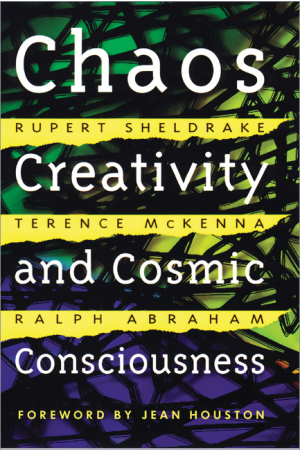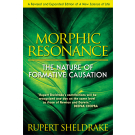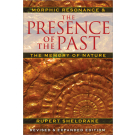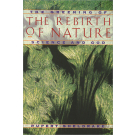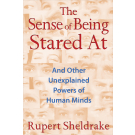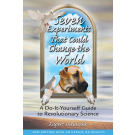Chaos, Creativity, and Cosmic Consciousness
- Edition: New Edition of Trialogues at the Edge of the West
- Pages: 208
- Book Size: 6 x 9
- ISBN-13: 9780892819775
- Imprint: Park Street Press
- On Sale Date: November 1, 2001
- Format: Paperback Book
- Illustrations: 23 b&w photographs and illustrations
• A wide-ranging investigation of the ecology of inner and outer space, the role of chaos theory in the dynamics of human creation, and the rediscovery of traditional wisdom.
In this book of "trialogues," the late psychedelic visionary and shamanologist Terence McKenna, acclaimed biologist and originator of the morphogenetic fields theory Rupert Sheldrake, and mathematician and chaos theory scientist Ralph Abraham explore the relationships between chaos and creativity and their connection to cosmic consciousness. Their observations call into question our current views of reality, morality, and the nature of life in the universe. The authors challenge the reader to the deepest levels of thought with wide-ranging investigations of the ecology of inner and outer space, the role of chaos in the dynamics of human creation, and the resacralization of the world. Among the provocative questions the authors raise are: Is Armageddon a self-fulfilling prophecy? Are we humans the imaginers or the imagined? Are the eternal laws of nature still evolving? What is the connection between physical light and the light of consciousness?
Part ceremony, part old-fashioned intellectual discussion, these trialogues are an invitation to a new understanding of what Jean Houston calls "the dreamscapes of our everyday waking life."
From Chapter 3 "Chaos and the Imagination"
TERENCE: The psychedelic revival is an effort to find our way back to something like the [Eleusiniam] mysteries. We are not the first nor the most eminent to suggest this kind of reengineering of the human animal.. I call attention to the words of Arthur Koestler, the great anticommunist freedom fighter and scientific intellectual. In a book called The Ghost in the Machine, he concluded that there has to be mass pharmacological intervention to change human behavior. He envisioned a drug that inhibits territoriality. Our reflexes and our mental set are highly and well adapted to the stoning to death of woolly mastodons, but, since we so rarely do that, we need to retool for living in peace while managing limited resources. The dissolving of boundaries by psychedelics certainly makes them candidates for antiterritoriality drugs.
RALPH: Do you think that some of our existing national holidays could be changed, or that a mythological mutation could be introduced that would go in this direction? For example, in Switzerland, they recently invented Fastnacht. They previously had no rituals at all, barely Christmas, and there was a suffering of enormous boredom among people there. It was said that there was no known way to make a new friend in Switzerland. So, just a few years ago, they instituted Fastnacht, in February. It is three days and nights of alcoholic revelry around the fantastic reenactment of a medieval drama. It involves people marching in the streets in parades led by musicians who have practiced a medieval song on medieval instruments all year long just for this three-day ceremony. Now it is said that, during Fastnacht, you can make a new friend.
TERENCE: Something along that line that I've advocated-sometimes facetiously, sometimes seriously-is calendrical reform, and I have just the calendar all worked out. I won't lay it all out here, but the basic notion is that it's a lunar calendar of thirteen lunar cycles. It has three hundred and eighty-four days, and consequently it precesses nineteen days against the solar year. This would have the effect of taking the great yearly events of the calendar and slowly moving them through the seasons. For instance, if we kept Christmas on December 25, and you as child celebrated Christmas in winter, then as a teenager you would celebrate it in spring, and as a young adult you would celebrate it in high summer. As an older person, it would occur in autumn, and then, when you were truly old, Christmas would return again to the winter.
The notion is to overcome the really bad dominator idea that the calendar should be anchored rigidly at the equinoctial and solstitial points so that the heliacal rising of the equinoctial sun is always in the same place. Our current calendar sends the message that there is stability. The calendar is the largest framework there is; in it, all other contexts are somehow subsets. The solar calendar is an effort to deny humanity's mortality by reinforcing a false notion of permanence. What we actually want is a calendar that says to us, "All is flow; all is flux; all relationships are in motion to everything else." This is a truer picture of the world. This may seem trivial, and exemplary of why we eggheads are harmless. But, think about it.
If we yield the structure of the calendar to the dominator culture, letting it tell us what kind of calendar we shall have, then we shall all live within the context of the dominator framework. Changing the calendar would have tremendous consequences, and it would not be opposed by the dominant culture until it was too late. It would be regarded as some kind of a crank thing, because it wouldn't be realized that we were twiddling with the dials of our whole civilization's image of time and change.
The year 2000 provides a built-in opportunity to switch the train to a new track because at these millennial moments there's a certain uncertainty in the mass mind about how to proceed. If you just jump up onto the stage and say, "This is it, folks!" you might be able to pull it off.
RUPERT: The first thing that occurs to me is that your idea of a lunar calendar in which the months and festivals move around the year is already in place. It's the calendar of the Islamic world. For example, Ramadan, the fasting month, retrogresses around the year., so people experience it both in winter and in summer in the course of their lives. This is not exactly a confirmation of your theory about such a calendar breaking the dominator mode.
TERENCE: Your point is certainly, um . . . unwelcome.
Chaos, Creativity, and Cosmic Consciousness
Illustrations
Acknowledgments
Foreword by Jean Houston
Preface
Chapter 1: Creativity and the Imagination
The new evolutionary cosmology. The regularities of nature as evolving habits. The basis of cosmic creativity. The cosmic imagination as a higher-dimensional attractor drawing the evolutionary process toward itself. The Omega Point. Imagination welling up from the womb of chaos. Psychedelic experience and the mind of Gaia. Gaian dreams and human history. Dark matter as the cosmic unconscious.
Chapter 2: Creativity and Chaos
The chaos revolution. Chaotic attractors as eternal mathematical realities. Indeterminism in nature. Chaos and the evolution of order. Form in the cooling process. The organizing fields of nature as related to mathematics and the cosmic imagination. Mathematical models. Attractors, attraction, and motivation. The freezing of information in crystals and in written language. The primacy of spoken language and abstraction.
Chapter 3: Chaos and the Imagination
Chaos in Greek mythology. The myth of the conquest of chaos. Fear of chaos and the suppression of the feminine. The partnership society and the rise of patriarchy. Seasonal festivals of the repression of chaos, and the creation of the unconscious. The inhibition of creativity and its relation to global problems. The Eleusinian mysteries. Creativity and Christology. Plans for the recovery of chaos and the imagination. The significance of the chaos revolution.
Chapter 4: The World Soul and the Mushroom
Randomness in the evolutionary process. The limited nature of models. The computer and chaos revolutions. Coevolution of mathematics and the material world. The mathematical landscape. Sensory qualities in the cosmic imagination. The similarities of souls and fields. The primal unified field and the fields of nature. Rebirth of the world soul. Interplanetary transfer of the human psyche via the psychedelic experience and the spores of magic mushrooms.
Chapter 5: Light and Vision
Physical light and the light of consciousness. Light and vision. The location of visual images. Mind extending from the eyes.The sense of being stared at: a new kind of field or the electromagnetic field? Hierarchy of fields in nature. Coupling between electromagnetic and mental fields. Physical light and self-luminous visions. Tryptamine hallucinogens. The world soul. Fields as the medium of divine omniscience. Gaian mind and the light of the sun.
Chapter 6: Entities
Discarnate intelligences and nonhuman entities: creatures within the human mind or truly Other? Entities and shamans. The use of language by entities. Angelic communication in the birth of modern science. The dream dimension and entities. The effect of science and humanism on entities. Nature magically self-reflecting and aware.
Chapter 7: The Unconscious
The three great bifurcations. Creation of the unconscious, the origin of evil, and the rejection of chaos. Escape from evil by the resurrection of chaos. The suppression of psychedelics, the patriarchy, and the rise of booze. Partnership and dominator drugs; the addiction to addictions. Habits and the formation of the unconscious. Holidays and the reinforcement of awareness. Prayer, magic, and astrology for enlightenment.
Chapter 8: The Resacralization of the World
Ralph's religious background. The sacred in India. Rediscovering the sacred in the West. The revival of ritual and the resacralization of music. Feminism and the archaic revival. Gothic cathedrals and animistic Christianity. The green movement, saving the Earth, the greening of God. Psychedelic churches. The resacralizing of science.
Chapter 9: Education in the New World Order
Education as initiation. The dominance of rationalism and humanism. Rites of passage. Summer camps. Testing and accreditation. Institutions and administrations. Workshops as a model for a new pluralistic and decentralized system of education. Religious initiations. Reform of existing professions. A possible pilot project.
Chapter 10: The Apocalypse
The apocalyptic tradition: a mythic model motivating religious history or an intuition of the ending of history or time? Modern millenarianism and scientific versions of the apocalypse. The possible end in 2012. The self-fulfilling quality of apocalyptic prophecy. The speeding up of history and the inevitability of planetary metamorphosis. Death and transformation on a cosmic scale. Intensifying conflict and the power of faith.
Glossary
Bibliography
About the Authors
Matthew Fox, author of Original Blessing
" Records the exciting intellectual friendship of three amazing minds pushing to the edge of history in search of a new consciousness blending scientific observation, mythical imagination, and visionary speculation."
Riane Eisler, author of The Chalice and the Blade
"Should be required reading for anyone who believes that science and spirituality cannot and should not interact."
Larry Dossey, M.D., author of Space, Time and Medicine
"One finishes Chaos, Creativity, and Cosmic Consciousness with a sense of heightened awareness and wonder."
ForeWord, 2003, Volume 6, number 2
" . . . represent[s] a very innovative and exciting new way of understanding life as we know it."
Gunnel Minett, breathe issue 89 - Sept., Oct., Nov. '02
“Records the exciting intellectual friendship of three amazing minds pushing to the edge of history in search of a new consciousness blending scientific observation, mythical imagination, and visionary speculation.”
--Riane Eisler, author of The Chalice and the Blade
“A book for all those who seek to quest beyond the limits of the ordinary. Three fine thinkers take us plunging into the universe of chaos, mind, and spirit. Instead of leaving us lost, they bring us back with startling insights and more wonder than we knew we had.”
--Matthew Fox, author of Original Blessing
“Should be required reading for anyone who believes that science and spirituality cannot and should not interact.”
--Larry Dossey, M.D., author of Space, Time and Medicine
This book is a vibrant discussion between three of the most original thinkers of our time as they blend science, creativity, intellectual curiosity, and traditional wisdom to explore and expand our current views of reality. The late psychedelic visionary and shamanologist Terence McKenna, acclaimed biologist and originator of the morphogenetic fields theory Rupert Sheldrake, and the mathematician and chaos theory scientist Ralph Abraham join forces to investigate the relationships between chaos and creativity and their connection to cosmic consciousness.
The authors challenge the reader to the deepest levels of thought with wide-ranging investigations of the ecology of inner and outer space, the role of chaos in the dynamics of human creation, and the resacralization of the world. Among the questions the authors raise are: Is Armageddon a self-fulfilling prophecy? Are humans the imaginers or the imagined? Are the eternal laws of nature still evolving? What is the connection between physical light and the light of consciousness?
Part ceremony, part intellectual and spiritual discussion, these trialogues are an invitation to a new understanding of what Jean Houston calls “the dreamscapes of our everyday waking life.”
RUPERT SHELDRAKE, Ph.D., the author of several books including Seven Experiments That Could Change the World, A New Science of Life, and The Rebirth of Nature, lives in England. TERENCE MCKENNA (1946-2000) was the author of Food of the Gods and The Archaic Revival. RALPH ABRAHAM, a Ph.D. in mathematics and a professor at the University of California, is the author of Dynamics: The Geometry of Behavior; he lives in California.



